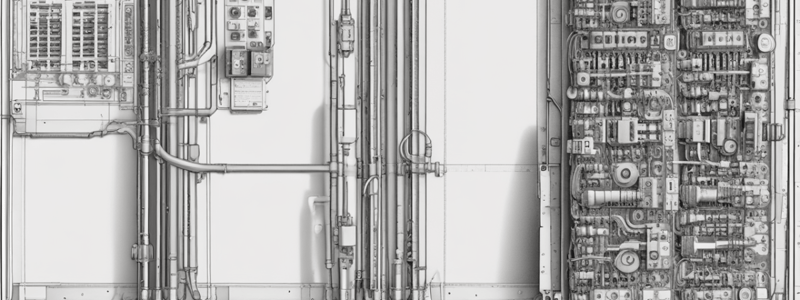Podcast
Questions and Answers
What advantage does a wireless input/output system have for industrial applications?
What advantage does a wireless input/output system have for industrial applications?
- It eliminates the need for any inputs or outputs.
- It increases the need for vendor-specific standards.
- It reduces the cost of running cables to each sensor. (correct)
- It allows for more complex wiring solutions.
What is the purpose of a discrete output in a PLC system?
What is the purpose of a discrete output in a PLC system?
- To interface with the human operator directly.
- To adjust a valve to a specific percentage.
- To turn a pump on or off. (correct)
- To log data trends over time.
Which standard was reported to be vendor specific and created by a consortium of companies?
Which standard was reported to be vendor specific and created by a consortium of companies?
- ISA 100
- Wireless Heart (correct)
- Wireless IO
- LoRa
What type of signal does an analog output provide?
What type of signal does an analog output provide?
In the context of wireless output systems, what is the function of a data historian?
In the context of wireless output systems, what is the function of a data historian?
Which of the following statements is true regarding the evolution of wireless IO technology?
Which of the following statements is true regarding the evolution of wireless IO technology?
What is the role of HMI in an industrial control system?
What is the role of HMI in an industrial control system?
Why might wireless networks be preferred in industrial settings despite the presence of wired systems?
Why might wireless networks be preferred in industrial settings despite the presence of wired systems?
What type of input indicates the current height of the tank?
What type of input indicates the current height of the tank?
Which of the following is an example of a discrete output?
Which of the following is an example of a discrete output?
What is the primary role of outputs in a PLC?
What is the primary role of outputs in a PLC?
How can outputs be structured in relation to communication networks?
How can outputs be structured in relation to communication networks?
What is an example of changing how fast a tank is draining?
What is an example of changing how fast a tank is draining?
Which of the following best describes digital outputs?
Which of the following best describes digital outputs?
What action will opening the inlet valve accomplish in the tank process?
What action will opening the inlet valve accomplish in the tank process?
What is the consequence of turning on an outlet valve in a tank system?
What is the consequence of turning on an outlet valve in a tank system?
Flashcards are hidden until you start studying
Study Notes
Inputs and Outputs in PLC Systems
- Outputs from a PLC control physical devices in a plant, such as pumps and valves.
- Discrete inputs indicate states, like whether a tank level is high or low, while analog inputs provide continuous measurements, such as current height.
- Adjusting the output can change the flow rate, e.g., turning a pump on is a discrete output command.
Control Mechanisms
- Output commands enable precise control of processes, such as:
- Turning on a pump to drain a tank.
- Opening an inlet valve to allow fluid into the tank.
- Managing outlet valves for liquid ejection from the tank.
- Fine adjustments can be made through analog outputs to modify flow rates more precisely.
Output Types
- Discrete outputs only have two states (on/off), suitable for simple commands.
- Analog outputs control devices at varying levels rather than just binary states.
- Outputs may be connected via a bus network, transmitting commands efficiently across a plant.
Wireless Communication
- Wireless networks can be utilized for outputs, providing flexibility without needing complex wiring.
- Examples include wireless commands to valves through the industrial internet of things (IIoT).
- Wireless telemetry enhances operations by reducing installation costs, especially in large facilities.
Standards and Protocols
- Vendor-specific concepts often lead to the development of standards, like wireless HART and ISA 100.
- LoRa (Long Range output standard) is emerging as a widely adopted protocol in both heavy industry and IoT applications.
Human-Machine Interface (HMI) and Data Management
- The HMI provides digital output information to operators, facilitating real-time control and monitoring.
- A data historian logs and trends information over time, crucial for long-term data analysis and operational improvements.
Studying That Suits You
Use AI to generate personalized quizzes and flashcards to suit your learning preferences.




